

FISHING • HUNTING • ADVENTURE AKSPORTINGJOURNAL.COM








PUBLISHER
James R. Baker
GENERAL MANAGER
John Rusnak
EXECUTIVE EDITOR
Andy Walgamott EDITOR
Chris Cocoles
WRITERS
Bjorn Dihle, Scott Haugen, Tiffany Haugen, Brian Kelly, Sean Nealon
SALES MANAGER
Paul Yarnold
ACCOUNT EXECUTIVES
Colleen Chittick, Mike Smith
DESIGNER
Lesley-Anne Slisko-Cooper
PRODUCTION ASSISTANT
Kelly Baker
WEB DEVELOPMENT/INBOUND
MARKETING
Jon Hines
ADMINISTRATIVE ASSISTANT
Katie Aumann
INFORMATION SERVICES MANAGER

Lois Sanborn
ADVERTISING INQUIRIES
media@media-inc.com
MEDIA INDEX PUBLISHING GROUP 941 Powell Ave SW, Suite 120 Renton, WA 98057 (206) 382-9220 • Fax (206) 382-9437 media@media-inc.com • www.media-inc.com

CORRESPONDENCE
Twitter @AKSportJourn


Facebook.com/alaskasportingjournal Email ccocoles@media-inc.com




ON THE COVER
The trout fishing was epic around Katmai National Park and Preserve’s Royal Wolf Lodge as Kansas-based filmmakers Blake Kresge and Austin Walsh chronicled the action in a promotional video they filmed for the lodge. (AUSTIN WALSH/MAMMOTH CREATIVE)
10 ALASKA SPORTING JOURNAL FEBRUARY 2023 | aksportingjournal.com
Volume 12 • Issue 9 www.aksportingjournal.com ZER Pistol Bullets and Ammunition Pistol Bullets and Ammunition Zero Bullet Company, Inc. P.O. Box 1188 Cullman, AL 35056 Tel: 256-739-1606 Fax: 256-739-4683 Toll Free: 800-545-9376 www.zerobullets.com
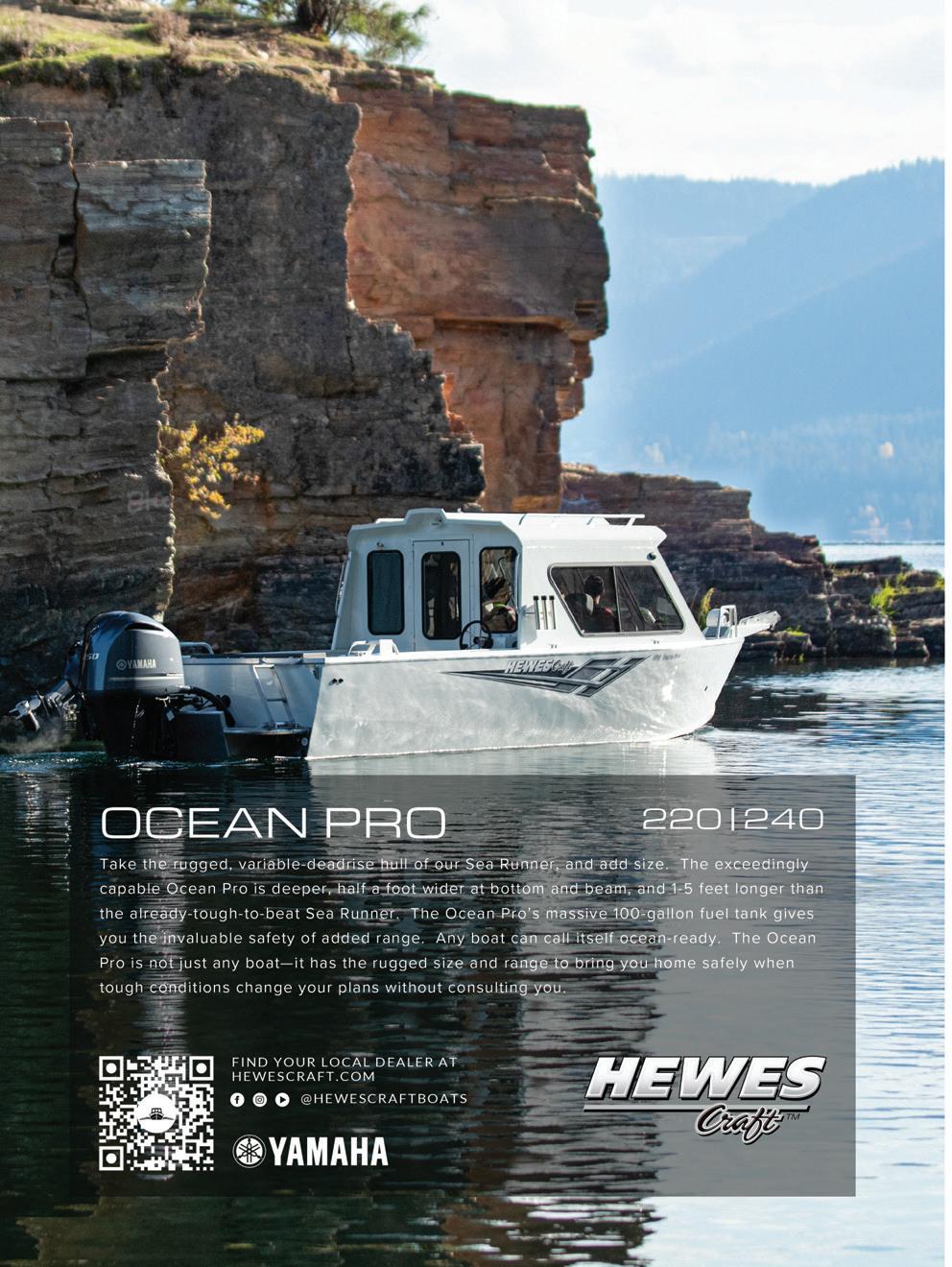
SPIN UP YOUR OWN COHO LURES


Some of the most enticing lures that Last Frontier salmon will strike are spinners, and patient, creative anglers with an artistic side can make their own that will drive coho crazy. With all the di erent blade patterns, color combinations and squid skirts, the sky’s the limit! Brian Kelly has a tutorial for DIY warriors.
FEATURES
24 WE AIN’T IN KANSAS ANYMORE!
A Kansas film crew duo traveled the rugged and beautiful area around Katmai National Park, Bristol Bay and the Alaska Peninsula as they shot a promotional video highlighting Royal Wolf Lodge and the region’s outstanding fishing. It was indeed an epic experience for first-time Last Frontier visitors Blake Kresge and Austin Walsh, who shared their stories of discovery with us.
53 BUILD A LIGHTWEIGHT BLIND
Like Brian Kelly’s build-your-ownspinner class elsewhere this issue, Scott Haugen also channels his inner Tim the Toolman Taylor with a how-to lesson on creating a lightweight, mobile duck blind that won’t burn through your hunting budget. And Ti any Haugen, the second half of our From Field to Fire team, adds a delicious, fruitforward smoked salmon recipe for the fish in your freezer.
58WHAT

HAPPENS WHEN WOLVES EAT
UP ALL THE DEER
Wolves inhabit many Southeast Alaska islands and in the Gustavus area they diminished deer numbers so much they were forced to find alternative food sources. Oregon State University’s Sean Nealon reports on a joint OSU-Alaska Department of Fish and Game study that identified the unexpected sea critter wolves are frequently seeking out to feed on.
ALSO IN THIS ISSUE
15 The Editor’s Note: Pebble Blocked By EPA In Final Determination!



19 The Alaska Beat
23 Outdoor calendar
39 Salmon carcasses help enrich Panhandle family’s veggie garden
(BRIAN KELLY)
12 ALASKA SPORTING JOURNAL FEBRUARY 2023 | aksportingjournal.com Alaska Sporting Journal is published monthly. Call Media Inc. Publishing Group for a current rate card. Discounts for frequency advertising. All submitted materials become the property of Media Inc. Publishing Group and will not be returned. Annual subscriptions are $29.95 (12 issues) or $49.95 (24 issues). Send check or money order to Media Inc. Publishing Group, 941 Powell Ave SW, Suite 120, Renton, WA 98057 or call (206) 382-9220 with VISA or M/C. Back issues may be ordered at Media Inc. Publishing Group, subject to availability, at the cost of $5 plus shipping. Copyright © 2023 Media Inc. Publishing Group. All Rights Reserved. No part of this publication may be copied by any means, electronic or mechanical, including photocopying or recording by any information storage or retrieval system, without the express written permission of the publisher. Printed in U.S.A. CONTENTS VOLUME 12 • ISSUE 9 47






Built for Adventure! THUNDER JET • BOULTON • FISHRITE With our factory-trained technicians for Yamaha, Suzuki, Mercury, Tohatsu and Honda motors, we can handle any project from electronic installs to complete boat and motor overhauls. MAXXUM MARINE 1700 Hwy 99 N, Eugene, OR www.maxxummarine.com Toll Free 877-4-Maxxum (877-462-9986) Local 541-686-3572 Need a new motor for your current boat? Best prices around on Repowers!
















































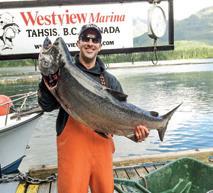





















250-934-7672 BOOK YOUR CANADIAN FISHING/CATCHING ADVENTURE NOW! www.WestviewMarina.com Westview Marina & Lodge is the largest provider of accommodation and moorage in the region! “BEST KEPT SECRET ON THE WEST COAST OF VANCOUVER ISLAND” “BRING YOUR LARGE COOLERS. YOU WILL NEED THEM WHEN YOU FISH WITH US!” WE HAVE NO FISHING RESTRICTIONS. FULL LIMITS ON KINGS, SILVERS, LINGCOD, HALIBUT & MORE! EARLY BIRD DRIVE-IN SPECIAL! BOOK NOW TO GET 2022 RATES FOR ALL 2023 BOOKINGS! 4 PERSON DRIVE-IN FISHING/CATCHING $2,100 ea. US • 4 Nights Lodging • 3 Full days of Guided Fishing / Catching • Salmon, Halibut, Lingcod & MORE • All your meals from our large restaurant menu ALL-INCLUSIVE PACKAGE SPECIAL 2023 CHARTER SCAN THIS FOR THE VIDEO
Iremember in January of 2014, just a few months after I started my now almost decade-long stint as editor of ASJ, I stood in a parking lot on a sunny but bitterly frigid day at Seattle’s Fishermen’s Terminal. It was an educational experience I continue to learn about in 2023.
The event that took place that day, a Stop Pebble Mine rally, featured impassioned speeches from Alannah Hurley, executive director of United Tribes of Bristol Bay, U.S. Senator Maria Cantwell (D-WA), Bristol Bay commercial fisherman Brett Veerhusen, and others. Their objections to Pebble, the proposed gold and copper mine, has carried on throughout my almost 10 years on the job, and the fight has appeared throughout the pages of this magazine, our website and social media pages.
And on the last day of January, just as we were sending this issue to press, the Environmental Protection Agency released its Final Determination with the intention to implement Clean Water Act protections on the Bristol Bay region for good.
“EPA issued a Final Determination under its Clean Water Act Section 404(c) authority to limit the use of certain waters in the Bristol Bay watershed as disposal sites for certain discharges of dredged or fill material associated with


deposit, a large ore body in southwest Alaska,” the EPA said.

“After extensive review of scientific and technical research spanning two decades, and robust stakeholder engagement, EPA has determined that certain discharges associated with developing the Pebble deposit will have unacceptable adverse e ects on certain salmon fishery areas in the Bristol Bay watershed.”
The EPA further reinforced that discharges of “dredged or fill material to construct and operate the proposed mine site alone would result in the permanent loss of approximately 8.5 miles of anadromous fish streams; 91 miles of additional streams that support anadromous fish streams; 2,108 acres of wetlands and other waters in the (South Fork Koktuli River) and (North Fork Koktuli River) watersheds that support anadromous fish streams.”
As you would expect, the pushback from Pebble proponents means the debate won’t simply go away right away despite this latest development that, for now, kills the project. Pebble Partnership, the parent organization behind the mine, stated it would likely pursue legal action from what it calls “the EPA’s preemptive action against Pebble.” (In a statement, longtime Pebble Mine supporter Mike Dunleavy, Alaska’s Governor, said,
stop any development project, mining or non-mining, in any area of Alaska with wetlands and fish-bearing streams,. My Administration will stand up for the rights of Alaskans, Alaska property owners, and Alaska’s future.”)
On the day the EPA’s Final Determination was released, I sent emails to filmmaker Mark Titus (The Breach, The Wild) and Trout Unlimited’s Marian Giannulis, praising them and others for their tenacity during this extended saga. Both o ered up emotional replies of gratitude for this moment. But I keep thinking about Hurley, whose Yup’ik people have relied on Bristol Bay’s salmon to sustain themselves and be their lifeblood for generations, and her resolve she showed me that day in Seattle so many years ago. Hurley was among those who spoke at a press conference on Jan. 31.
“Many of those who began the battle are no longer with us. New generations of our people have been born and raised with the cloud of Pebble hanging overhead,” she said, adding that so many people have worked to “defend the last great wild salmon fishery left on the planet. Today’s announcement is historic progress toward that goal.”


And we’ll continue to report on this fight that’s so meaningful to Alaskans and so many more.
-Chris
aksportingjournal.com | FEBRUARY 2023 ALASKA SPORTING JOURNAL 15
EDITOR’S NOTE
development of a mine at the Pebble Dunleavy, “Alarmingly, it lays the foundation to and so many more.
Cocoles
As permanent protections from the Pebble Mine were finalized by the federal Environmental Protection Agency late last month, opponents of the mine celebrated the safeguarding of sockeye salmon, the lifeblood of the Bristol Bay watershed, and the waters and lands they and so many others depend on. (JOSH BLOUIN/U.S. FISH AND WILDLIFE SERVICE)
ANCHORAGE
ALASKA
Anchorage Yamaha Suzuki Marine 3919 Spenard Rd (907) 243-8343

anchorageyamaha.com
FAIRBANKS
Northern Power Sports 1980 Van Horn Rd (907) 452-2762
northernpowersports.com
16 ALASKA SPORTING JOURNAL FEBRUARY 2023 | aksportingjournal.com



18 ALASKA SPORTING JOURNAL FEBRUARY 2023 | aksportingjournal.com
BAIT AND DITCH? PARK SERVICE SEEKS AN END TO BEAR BAITING ON ALASKA NATIONAL PRESERVES

While Alaska continues to be one of the only regions in North America that permits grizzly bear hunting, a new federal proposal would prohibit hunters on national preserves from drawing in bears by putting out bait such as doughnuts, dog food or bacon grease, among other attractants.

The controversial move would reverse a former President Donald Trump administration policy known as the 2020 Alaska Hunting and Trapping rule.

According to a National Park Service press release, that decision introduced “several controversial sport hunting practices, including bear baiting. The new regulation would reduce visitor use conflicts and concerns over potential safety issues related to bear baiting and would also restore consistency between harvest practices allowed in national preserves and NPS management policies with respect to natural processes, abundances and wildlife behavior.”
The new regulations wouldn’t prevent hunters from utilizing bait stations to attract bears in other game management units of the state not on federal land, nor would it a ect subsistence hunts on national parks/preserves. But President Joe Biden’s NPS aims to reverse course from the previous administration’s U-turn that had allowed bear baiting following a 2015 federal determination barring it.
“We take seriously our responsibilities under the Alaska National Interest Lands Conservation Act and the NPS Organic Act, which include mandates for hunting while also conserving and protecting wildlife in our national preserves,” NPS Alaska regional director Sarah Creachbaum said. “This proposed rule would realign our e orts to better manage national preserve lands in Alaska for natural processes, as well as address public safety concerns associated with bear baiting.”
AL ASKA BEAT
TWEET OF THE MONTH





It’s safe to say that there are plenty of other Alaska communities that could successfully market a similar T-shirt.





aksportingjournal.com | FEBRUARY 2023 ALASKA SPORTING JOURNAL 19
A new federal proposal would prohibit taking bears via bait on national preserve lands within Alaska. (KATMAI NATIONAL PARK AND PRESERVE)
In a state where the wildlife is as much celebrity as many of the humans, a dog-walking biz in Skagway went viral for transporting its customers on a “dog bus.”
“ ”
THEY SAID IT
“This damaging sale never should have happened in the first place, and we’ll continue challenging it in court and fighting to preserve beautiful Cook Inlet. We urge Biden not to issue any leases without meaningful consideration of drilling’s threats to local communities and wildlife like the endangered Cook Inlet beluga whales, as he’s required to do by federal law.”
–Kristen Monsell, oceans legal director at the Center for Biological Diversity, after the Bureau of Ocean Energy Management’s Inflation Reduction Act-mandated Lease Sale 258 late in 2022 received just one bid.
FROM THE ASJ ARCHIVES – FEBRUARY 2019 COAST GUARD
PETTY OFFICERS’ LOVE STORY ON KODIAK ISLAND
For Petty O cer First Class Ashley Wallace, a Coast Guard yeoman, occasionally her blue uniform is hung in the closet and replaced with camouflage, zero-degree thermals and hunting boots.
On weekends, she and her husband, Petty O cer First Class yeoman Branson Wallace, layer up, pack their rifles, emergency signaling devices and a surplus of food and clothing. They like to escape the daily grind while experiencing some of the world’s best hunting and fishing opportunities on Alaska’s Kodiak Island …

“My husband and I got orders to Kodiak

in 2013 and knew nothing about Kodiak, but we were so excited,” Wallace says.
“We started helping teach at North Star Elementary where they were introducing the National Archery School program in town,” says Wallace. “It’s been part of the Alaska school curriculum or extracurricular activities since 2013, where they teach kids how to shoot compound bows. It was a very cool experience to see them fall in love with archery at such a young age, like I did.”
From there, Wallace says she and her husband got into fishing. But, after the
thrill of fishing, it wasn’t long before it gave Wallace an itch to begin hunting, since hunting from a boat is common in parts of Alaska.
“I wanted to spread my wings a little bit, so Branson and I bought a boat,” says Wallace.
“I think it’s important that they [women] see that you can be the girl that puts on makeup and dresses up, and then all of a sudden you’ve got war paint on, and you’re in camo, and guttin’ something and haulin’ meat out,” she adds. -U.S. Coast Guard Petty O
20 ALASKA SPORTING JOURNAL FEBRUARY 2023 | aksportingjournal.com
Coast Guard Petty O cers Ashley Wallace and her husband Branson Wallace had a memorable outdoors experience when they were stationed on Kodiak Island. (ASHLEY WALLACE)
NOTABLE NUMBER
cer Third Class Lauren Dean
62
Number of Prince of Wales Island wolves that trappers took during a reduced month-long season from November to December.


aksportingjournal.com | FEBRUARY 2023 ALASKA SPORTING JOURNAL 21
OUT

Where











the fish come to you!
BRISTOL BAY, ALASKAWorld-Class Fishing



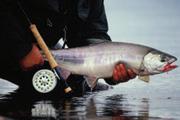







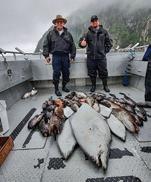
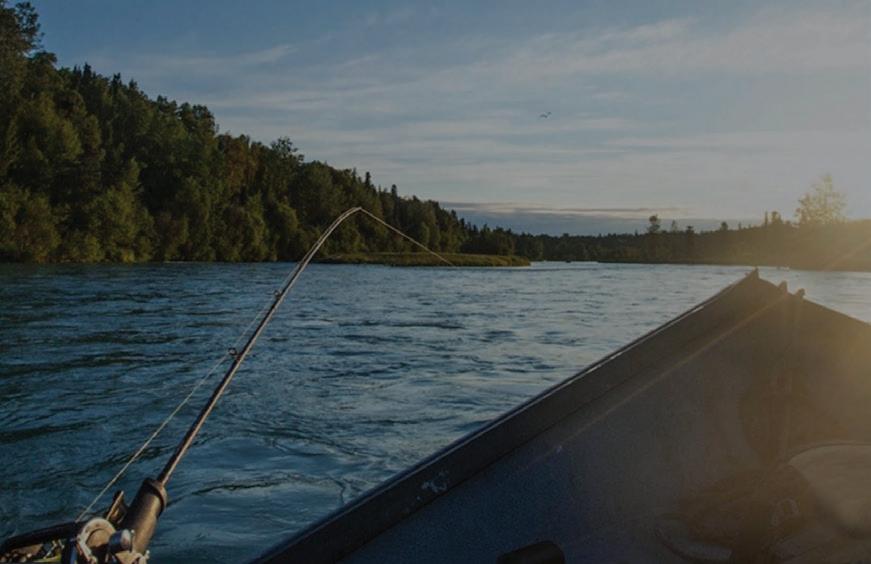
The Alagnak Lodge sits atop a bluff overlooking the wild and scenic Alagnak River in the heart of Alaska’s premier wilderness fishing area, the Bristol Bay watershed. Each summer millions of wild salmon pass our front door as they enter their river of birth for spawning. We have very good runs of all five salmon species as well as resident rainbow trout and increasingly exceptional silver runs.
Optional fly outs are always available to expand your experience.
Since 1982 and constantly upgraded …Highly rated experienced guides… Fish as you want to fish…gear & waders provided…flexible schedule… Quick access to the best fishing on the River…Highly praised cuisine Ten guided boats limited to 2 guests per boat, so call now to secure your spot.
22 ALASKA SPORTING JOURNAL FEBRUARY 2023 | aksportingjournal.com FISH
OCEAN CHARTERS
OF SEWARD AND HOMER
THE
EPIC FLY OUT TRIPS TO REMOTE ALASKA WATERS OUR FLY OUT TRIPS ARE THE BEST WAY TO EXPERIENCE ALASKA. LET US HELP YOU PLAN THE ALASKAN FISHING TRIP OF A LIFETIME. CALL 877.262.4779 OR VISIT ALASKAFISHINGLODGES.US TO RESERVE YOUR ADVENTURE TODAY.
THE LAST FRONTIER WITH THE BEST GUIDES IN THE BUSINESS ALASKAN
FISH FOR MULTIPLE SPECIES IN SOME OF
BEST WATER IN ALASKA.
Photo: Ed Sozinho
Photo: Mark Sargent
Call 1-800-877-9903 www.alagnaklodge.com E-mail fish@alagnaklodge.com
Photo: Thomas Woelfle
OUTDOOR CALENDAR
Feb. 5 Yukon Quest sled dog race begins, Fairbanks (yukonquest.com)
Feb. 15 Wolverine season opens in Game Management Units 3 (Petersburg/Wrangell) and 4 (Admiralty/Baranof/ Chichagof Islands)
Feb. 17 Results of Draw, Tier I/II and Community Subsistence Harvest applications expected to be released (adfg.alaska.gov)


March 4 Scheduled ceremonial start of Iditarod sled dog race, downtown Anchorage (iditarod.com)
March 15 Spring brown bear season opens in GMU 1 (Southeast Mainland)
March 15 Resident spring brown bear hunting season opens in GMU 3
March 16 Early resident caribou season opens in GMU 26A (Arctic Slope)

March 18 Homer Winter King Salmon Tournament (homerwinterking.com)



April 21-22 Safari Club International Alaska Chapter Alaskan Hunting Expo and Sportsman’s Banquet; Dena’ina Center, Anchorage (907-903-8329; aksafariclub.org)
2023 SPORTSMAN’S SHOWS
Feb. 1-5 Washington Sportsmen’s Show, Washington State Fair & Events Center, Puyallup, Washington (otshows.com)

Feb. 15-19 Pacific Northwest Sportsmen’s Show, Expo Center, Portland, Oregon (otshows.com)
March 24-26 Mat-Su Outdoorsman Show, Menard Center, Wasilla (matsuoutdoorsmanshow.com)

March 29-April 3 Bart Hall Shows, Long Beach Convention Center, Long Beach, California (hallshows.com)

April 14-16 Great Alaska Sportsman Show, Dena’ina Civic and Convention Center, Anchorage (greatalaskasportsmanshow.com)
April 21-23 Fairbanks Outdoor Show, Carlson Center (fairbanksevents.com/outdoor-show)

For more information and season dates for Alaska hunts, go to adfg.alaska.gov/index.cfm?adfg=hunting.main.

aksportingjournal.com | FEBRUARY 2023 ALASKA SPORTING JOURNAL 23
Have you applied for a draw or Tier 1/Tier II Alaska hunt? The Alaska Department of Fish and Game plans to release draw results on Feb. 17. Check the ADFG website (adfg.alaska.gov) for more.
(U.S. FISH AND WILDLIFE SERVICE ALASKA)
kenairiversuites@gmail.com www.kenairiversuites.com | (907) 262-1992
Located in the Heart of Soldotna, Alaska on the World Famous Kenai River!
*Private
907-260-FISH (3474) kingsalmondeaux33126@gmail.com www.kingsalmondeauxlodge.com
*Kenai Riverfront Suites *Full kitchens, 2 bedrooms *Jacuzzi Suite
River access for Fishing
*Open
year round
• Kenai Riverfront Cabins • Bank Fishing • Over 700 ft. of River Frontage
FROM KANSAS TO KATMAI, WITH CAMERAS IN TOW




24 ALASKA SPORTING JOURNAL FEBRUARY 2023 | aksportingjournal.com
FILMMAKING DUO GET WELCOME-TO-ALASKA MOMENTS WHILE CHRONICLING FISHING LODGE
 BY CHRIS COCOLES
BY CHRIS COCOLES
They had a feeling they weren’t in Kansas anymore. They may not have been flying over the Land of Oz, but the Wonderful Wizard must have had something to do with the spectacular views. And if their final destination –Katmai National Park and Preserve –wasn’t the Emerald City, it must have been the jewel of this kingdom.
As the fourth of four total flights landed at their final destination, filmmakers Blake Kresge and Austin Walsh had stepped on Alaska soil for the first time. They had no idea what to expect for their assignment to shoot a promotional video for a remote fishing lodge, but it didn’t take long for the Kansans to realize they’d be in a special place.

“There’s nothing like it. Every place you go feels untouched” Kresge says.


Adds Walsh, “It was pretty wild. It’s almost hard to describe … I don’t even know if I took enough time to stop and absorb it, because we were just in go mode. You’re hiking, you’re doing this and that – just always on the move. So that was great. But the whole week was just incredible.”

FISH OUT OF WATER
Kresge, the lead filmmaker for Mammoth Creative Co. (785-4006136; mammothcreated.com), a production company based in Meriden, Kansas (just north of Topeka), and director of photography Walsh, have a diverse portfolio in the projects they’ve collaborated on or done independently – from sporting events to chamber of commerce promotional assignments to portraits of front-line workers during the Covid pandemic. But this Alaska adventure in tagging along with fishing guides and clients of Katmai’s Royal Wolf Lodge (541-993-0577; royalwolflodge .com) and capturing the perfect moments
aksportingjournal.com | FEBRUARY 2023 ALASKA SPORTING JOURNAL 25
A fly angler fishes some of the best waters Alaska has to o er. Filmmakers Blake Kresge and Austin Walsh took this and other photos during their time at Katmai National Park’s Royal Wolf Lodge near Bristol Bay and the Alaska Peninsula. (AUSTIN WALSH/MAMMOTH CREATIVE)
would be a challenge in their own right.
“I’m not a fisherman. You’ve got the guys who shoot for Patagonia; they live outdoors. We get to experience all kinds of stu . A couple weeks later I’m down in Oklahoma shooting a college football game. It’s so varied, but we love shooting outdoors,” Kresge says.
“We really latch onto the outdoors, and so this is up our alley, but we’ve never done it, never chased it.” Walsh, who is actually based just across the Kansas border in Kansas City, Mo., grew up on a lake in Missouri and fished with his grandfather as a kid, but he certainly wouldn’t consider himself
a diehard angler. But telling the lodge’s story through their creative lenses was the kind of challenge they crave.
“For us every week it’s a di erent story, so we’re always kind of adapting. I’ve done a lot of tourism work, so it’s a lot of adventure and on-the-go type of stu ,” Walsh says. “But what the challenge was, was we got rained on probably every single day and went in and out of airplanes every single day. We’d be standing in running water shooting fishermen while you’re being pushed downstream. It was probably one of the most physically demanding projects I’ve ever worked on.”
“We had not been in Alaska for 24 hours and we had just landed in this little puddle of water on the coast,” director of photography Austin Walsh says. “We flew from Royal Wolf over the bright blue Battle Lake towards Mount Douglas. We landed a little inland from McNeil Cove and hiked about a mile to the river.” (AUSTIN WALSH/MAMMOTH CREATIVE)

SPECTACULAR SCENERY
As you’d expect, getting from Kansas to Katmai isn’t an easy point A to point B trip – more like points and points and more points. Kansas City to Seattle; Seattle to Anchorage; Anchorage to Iliamna; Iliamna to the lake adjacent to Royal Wolf Lodge.
Some of the flyover enroute to that final watery landing spot was some of the greatest moments Kresge and Walsh would remember.
“We went through a whole bunch of passes that were just beautiful and that sometimes are not super visible. It was a pretty clear day,” Kresge recalls. “I got
26 ALASKA SPORTING JOURNAL FEBRUARY 2023 | aksportingjournal.com
some beautiful pictures from my iPhone that I didn’t expect. We were about to take o and they were like, ‘By the way, this is going to be awesome.’”
Sure enough, it was just the beginning of a week full of similar opportunities many Lower 48ers only dream of.
One of Walsh’s lasting memories was totally random and unexpected – the kind of spur-of-the-moment surprises only remote Alaska can bless visitors with.

“We kind of had a little bit of a relaxing day and Blake and I were kind of focusing on the food, the lodging and kind of more of the resort side of the project,” Walsh says.
“At like 3 in the afternoon one of the pilots came back from a run and he said, ‘Oh man. I just flew over this waterfall that I’ve never seen before. Do you want to go check it out?’ ‘You don’t say no to that, so let’s go.’ And so just like at the drop of a hat it was, ‘Get your waders on, head to the plane.’ We flew and landed in this little lake and it was a couple-mile hike to see this waterfall, which was awesome. So it was like going on a Target run after work. It was, ‘Hey! I saw a thing. Do you want to go look at it?’ It was only a 15-minute flight, but it was just a weird sequence of events – from taking it easy to being in a plane to staring a waterfall. It was wild.”
SHARING THE TROUT WITH FRIENDS
On their first full day, Walsh and Kresge flew with a fishing party out to a coastal location to target silver salmon.
“We went out pretty far out west. (Lodge manager Nate Morris) was looking for silvers and had gotten a tip that this area was good. So on day one we kinda went exploring. If you want to get thrown in the fire, that’s it. It was marshland; you stand there, you sink. Hike out there in a bunch of thick brush, where if you fell you got caught by the brush that you had to get (through to get) down to where the good fish are at,” Kresge says. “That first 24 hours was
aksportingjournal.com | FEBRUARY 2023 ALASKA SPORTING JOURNAL 27
amazing. With what we do a lot of times, we get put into situations that we’d never been in and we get to experience it and capture it.”
The remainder of the week was something of a voyage of discovery for the Kansas duo. Royal Wolf Lodge’s location alone is a filmmaker/photographer’s dream. But the short flights via floatplane
taking o from the lake a half-mile hike away from the lodge meant new locales, new thrills and new chills. Trout in the nearby rivers – a puddle hop away from the lodge – became the focal point for Kresge and Walsh as they filmed the guides and clients casting flies.

If there were supporting actors, it was the bears that shared the water and the
fish everyone wanted a crack at.
“We saw a lot of bears. That was wild and we saw so many that halfway through the day it wasn’t even a big deal. When we first landed at this one river, it was like, ‘Hey; there’s a bear; shoot it.’ And then by the end it was, ‘Who cares about all those bears?’ It got so normal,” Walsh admits.
Kresge laughed about one of the first times they realized the local fauna would be part of the show when going over plans for one of the days’ activities.
“The clients are talking about seeing bears and Austin and I raise our hands and ask, ‘What’s the protocol?’ They said ‘We’ll be safe about it. We understand their behavior. They’ve had a good summer. They shouldn’t care about you.’ We’re experiencing a bear every hundred feet. You can go through our video and photos and it’s bear, bear, bear, bear. But it’s strange; you just get used to it. It becomes a reality. It goes from, ‘Holy crap! There’s a bear,’ to just kind of quietly point it out so we know our surroundings.”
It was hard to argue with the bruins, which had the same goals as the anglers and the guys with the cameras and the videos.
“They’ll be across the water from you and they’ll get their food. Just from my experience, as long as humans don’t mess with them, they won’t mess with humans. Everyone gets their fish and
One of the best parts of this filming experience was when the Kansas visitors went to fishing spots that even the guides had never experienced before. (AUSTIN
WALSH/MAMMOTH CREATIVE)
28 ALASKA SPORTING JOURNAL FEBRUARY 2023 | aksportingjournal.com

everyone is happy,” Kresge says.
“We’re taught to be afraid of bears. A healthy fear of bears is fine, but up there it’s pretty clear to me: They become part of the scenery and they’re fishing just like you are.”
UNEXPLORED GEMS

What fascinated the filmmakers was the scope of the region of Alaska they explored. Of course, they had no idea what lay ahead on the floatplane expeditions – see the waterfall that the pilot breezed over and brought the visitors back for a closer look.

“One of the most memorable things about this trip was the friendships made with the guides and sta . They took Blake and I in like we were one of them,” says Walsh. “We ate, drank and told stories together at the end of each day. I learned that ‘Crush Days” are the best.” (AUSTIN WALSH/ MAMMOTH CREATIVE)
On a flight back to the lodge a pilot spotted this waterfall, which led to a spontaneous chance for the two photogs to see the gorgeous spot, symbolic of the anything-can-happen-in-Alaska experience. “We got our gear packed up, jumped in one of the Helios, and flew to the closest lake to land and started hiking,” Walsh recalls. “He dropped us o , went for his pickup, and said he’d be back in 50 minutes.” (AUSTIN WALSH/MAMMOTH CREATIVE)
30 ALASKA SPORTING JOURNAL FEBRUARY 2023 | aksportingjournal.com








aksportingjournal.com | FEBRUARY 2023 ALASKA SPORTING JOURNAL 31 DocksideDepoeBay.com Call: 541-765-2545 or 800-733-8915 270 Coast Guard Dr, Depoe Bay Check our website for Daily Fishing & Whale Watching reports. Thank you so much to everyone who voted for us! We are truly grateful for everyone’s support and we are very proud to provide the BEST Charter Fishing and Whale Watching Service to all of our customers and to our community! VOTED #1 Charter Fishing and Whale Watching Service
But there were places even these grizzled locals were unaware of.
“Another thing that was weird, because Royal Wolf has the three planes and kind of go anywhere they want up in that region, I think there were two di erent times where Nate and another guide said ‘We’ve never been here.’ And I’m like, ‘You live here! This is your area!’” Walsh says. “But there are so many
areas to choose from. They’d hear that the good fish were somewhere. ‘Let’s go check it out.’ And that’s what we did.”
Walsh also remembered that on one flight, the plane flew over Battle Lake, a 9-mile-long narrow body of water on the Alaska Peninsula. As the adventurous Alaskan bush pilot and plane full of anglers often do, someone suggested they land on that remote lake and check

it out from the water.
“Again, it was a case of, ‘Do you want to land in that?’ ‘Sure.’ And you just do it. So that was weird. And it was so blue it seemed like we were standing in a bottle of Windex,” Walsh says.
For Kresge, one of his regrets was not taking up an o er to man one of the fishing rods and pull in one of the many rainbows that succumbed to the flies at the end of the lines. But being there strictly to work and record every critical moment on film, the angling temptation was trumped by potentially missing the money shot.
“I had a camera (version of) FOMO of missing out on one moment. We kept the cameras in our hands at all times. Who knows if you’re downstream fishing and someone else gets the biggest fish of the week? It’s hard. It got o ered to us a dozen times,” Kresge says. “And it’s not like we weren’t willing. We wanted to show what the experience is and if the best part of the week doesn’t get captured because we’re playing, I’d never stop thinking about that.”
WATCHING ARTISTS AT WORK
Both film collaborators were asked how they’d approach the process of choosing from the hours upon hours of footage they’d compile to create a short film that would showcase why Royal Wolf Lodge checks the boxes of those fishing fanatics looking for an Alaska trip of a lifetime. As you’d guess, there was a lot of magic that an amateur photographer could make quite a clip out of. So how do they narrow it down?
“You watch the videos (before you go) and kind of visualize it. But until you can see it and smell it and feel it, it’s not real. I’m proud of the video, but it’s just a taste of what it is,” Kresge says. “My expectations were, ‘We’re gonna bust our butts, we’re going to go places we don’t know and we’re going to have to change what we’re doing in 10 minutes.’ Just kind of ‘go out there with an open mind.’ We didn't go out there with an idea of what you’ll see in a video.”
Royal Wolf’s guides themselves also made the task of sharing the lodge’s story easier. They found some of the most insanely beautiful spots on Alaska’s Bristol Bay and the Peninsula.

32 ALASKA SPORTING JOURNAL FEBRUARY 2023 | aksportingjournal.com
Walsh called this heart-inspired spot “a sign of love from Alaska.” (AUSTIN WALSH/MAMMOTH CREATIVE)


aksportingjournal.com | FEBRUARY 2023 ALASKA SPORTING JOURNAL 33
They did tireless research every night leading into the next day’s adventures.
“If you want to see people who are dedicated to their craft, check out those guides. I’d grab a co ee in the morning and five of them would be sitting there talking about where the next hot spot might be, or what they’d found the day before. They’re drawing maps and they’re sharing as much as they can to get the clients the best experience possible,” Kresge says.
“I know they’re there to work, but a lot of people turn their work o at night, but with them that’s not the case. Not to say they don’t have other interests, as other things came up, but it always came back to fishing. And seeing how excited they were, it wasn’t about them catching fish because they’re guides. If someone is having a great day, they’re having a great day.”
Walsh left the lodge knowing he’d made some new friends. One of the guides who spends part of his season guiding in Minnesota invited him up to join him in the future.
“They’re a crazy bunch; there’s a dozen people who are secluded from the rest of the world for months at a time. And they took us in like one of them,” Walsh says. “We got to know them and we all follow each other on social media now and keep in touch.”
And as they headed back to the Midwest after their late August/early September taste of the Last Frontier, both of the filmmakers moved onto other projects – Kresge shot a college football game and Walsh talked about an upcoming gig promoting hunting and fishing topics with the Kansas Department of Wildlife and Parks.
But what about a return engagement to Alaska, whether for business or pleasure? No question they want to get back for another round.
Walsh, who found Alaska as intoxicating as the time he and his family annually vacation in Summit County, Colorado, described that flight on the first day when the anglers fished for coho around the Alaska Peninsula coast.
“We woke up, took a half-mile hike down to the lake and we flew to the coast and fished this area that they’d never been to, landed in this tiny puddle of a pond, and it was the only sunny day,”
This is what these lodges are all about for their clients: trophy fish like this rainbow. Guides Sky and Scott took their party out in the rain to several spots but didn’t find any action until they finally struck gold in a spot they nicknamed “Sky Point because of how much action we ended up getting,” Walsh says.

34 ALASKA SPORTING JOURNAL FEBRUARY 2023 | aksportingjournal.com
(AUSTIN WALSH/MAMMOTH CREATIVE)

aksportingjournal.com | FEBRUARY 2023 ALASKA SPORTING JOURNAL 35
he says. “It was amazing and beautiful. Nobody – the guide, the pilot – had ever been to this place before. And it looked like nobody had been there for months, so it was just the idea of within 24 hours of even being in Alaska, we’re just in the middle of nowhere and in a body of water staring at Mount Douglas. It was just insane.”
Kresge too would like to go back again. He rued the reality that he didn’t get within sni ng distance of a moose in the Alaska wild, despite his pre-trip research that clarified how dangerous moose can be around humans. (“My girlfriend asked if I was coming back or if a bear was going to eat me,” he jokes.)
“We’re trying to figure out how to go next summer. We’ve talked about it. There’s always that itch. For me I’m not often wading around in a river. There’s not a whole lot of experiences like that. But I’d be happy to go back to Alaska next week,” Kresge says.
“It really is a once in a lifetime trip. I hope it isn’t my only once in a lifetime (opportunity). It’s so untouched; it’s wild. It’s a really cool experience. Not
often do you get to take a choose your own adventure trip.”
POETRY IN MOTION
Mammoth Creative released a condensed version of the Kresge-Walsh Royal Wolf Lodge video that summarized some of the action they shot. But they were also impressed with some of the down time they spent at their home base for the week.
“The lodge is beautiful. I was there to work, but in the evenings we still got a chance to enjoy it and talk to some of the clients who were there. It was once in a lifetime for them,” Kresge says. “Again, I didn’t walk in as a client, but you’re treated like royalty. I don’t know where else you’d get that experience. It’s great food from start to finish; it’s very capable pilots; I’ve got no negatives. You can have a wild Alaskan experience by day and a relaxing evening by night.”
In the video, a narrator recites the verses of a 1907 poem, “The Spell of the Yukon,” written by late 19th and early 20th century British-Canadian writer Robert W. Service.
At a campfire during one of those quiet evenings at the lodge while Walsh and Kresge were there, one of the guides recited the poem (a former client once also read it out loud to the lodge’s sta ). The words moved the filmmakers and resonated so much as they edited their material.

Amid a backdrop of pristine waters, fly anglers casting and landing trophysize rainbows, floatplanes taking o and landing and bears curiously watching the play by play, Service’s thoughts complement the scene:
“There’s a land where the mountains are nameless,
And the rivers all run God knows where; There are lives that are erring and aimless,
And deaths that just hang by a hair; There are hardships that nobody reckons; There are valleys unpeopled and still; There’s a land – oh, it beckons and beckons, And I want to go back – and I will.” ASJ
Editor’s note: Watch the video Blake Kresgeand Austin Walsh-created and -produced film at vimeo.com/765908250/11430d0f10.
36 ALASKA SPORTING JOURNAL FEBRUARY 2023 | aksportingjournal.com












38 ALASKA SPORTING JOURNAL FEBRUARY 2023 | aksportingjournal.com All summer long we can give you the chance to fish world class trophy salmon on the Kenai as well as record halibut on your same visit. Whether it’s fishing the upper Kenai River June through October for beautiful rainbow trout; enjoying feisty action from the Silvers beginning in August; sightseeing over Alaska’s majestic ice fields and glaciers; or arranging for a fly-in fishing adventure – we can accommodate you. When you fish with RW’s, you will experience the fishing vacation of a lifetime. 907-262-7888 /// www.rwfishing.com /// rwfishing@hotmail.com RW's Fishing & Big Eddy Resort Soldotna, Alaska $1977 / person 6 Nights / 4 Days 2 Salmon + 2 Halibut 2 Bedroom Condos • Completely Furnished Free Fish Processing Offer good May 18 – June 30, 2023 Time & Space Limited • Reserve Today! Offer Expires April 15, 2023 RW’S EXCLUSIVE OFFER
Just as returning salmon provide marine nutrients such as nitrogen to Southeast Alaska forests when their half-eaten carcasses are left there by bears – a storied streamside ecological web – so too are scraps from harvested fish used to enrich local residents’ gardens. (BJORN DIHLE)
SALMON IN THE GARDEN
FAMILY USES EVERYTHING IT CAN FROM HARVESTED FISH, INCLUDING IN THE GROUND
BY BJORN DIHLE
Last fall my partner MC and I bought a house near the Mendenhall Glacier with big garden beds in the backyard. It had been a long while since the beds were tended.
Hidden in the forest of weeds were artistically painted signs with the names of vegetables planted years ago. There were gardening tools, seed planters and grow lights in the sheds. Whoever lived here had invested a lot of care and energy in growing their food. Neither MC nor I knew much about gardening. Now, it was up to us to bring the garden back to life.
Behind the garden plot are woods and a trail that leads to a stream where, as we explored our backyard for the
first time, a small run of coho salmon was spawning. Our 2½-year-old son watched, mesmerized, as salmon jockeyed for position above redds, while our six-month-old slept on my back.

I was struck by the similarities between salmon spawning and gardening. Salmon dig gravel nests to “plant” and “fertilize” their eggs. Sediment, temperature and other environmental elements have to be just right in order for eggs to hatch and for a salmon to grow.
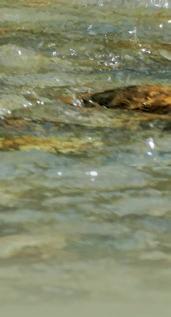


Some of my earliest memories are of hundreds of pink salmon spawning in a creek on Admiralty Island. The forest and wall of salmonberry brush towered above me. Eagles carrying the flesh and guts of salmon in their talons winged through



the maze of trees. Partly eaten carcasses lay strewn over gravel. Ravens, seagulls and other birds pecked at eggs and guts. Brown bear tracks lined the bank. The visceral hold bears’ presence had on me then hasn’t changed much 35 years later. I watched my older boy staring at salmon and wondered what memories he’d count as his first. After a half hour, I tried to get him to leave. He threw a tantrum but took solace in my promise we’d come back soon to visit the salmon.
FALL IS HARVEST SEASON in Alaska. I’d been away for almost four months guiding natural history film crews after brown bears, and our freezer was nearly empty. My brothers gave us a number of

aksportingjournal.com | FEBRUARY 2023 ALASKA SPORTING JOURNAL 39
king and sockeye, but we needed more salmon for the winter.
There were coho schooling up on the nearby Mendenhall Wetlands. When the tide was right, I slipped away and fished until we had enough for the year to come. Some I’d smoke, some would be baked, blackened on cast-iron skillets or grilled. I saved the carcasses to put in the garden beds as fertilizer, after the majority of bears had denned for the winter. Once we added a few deer to the freezer, I began working on the garden.
My son “helped” pull weeds, pick out rocks and turn the soil. My dad helped plant garlic. While I gathered seaweed to put on the beds, my son would play with salmon bones, pretending they were

dinosaur bones.
The pink salmon run had been decent in the streams on Chichagof Island I’d been guiding that August. On one “average” stream, I estimated there were around 30 di erent brown bears utilizing the first mile. Each bear – besides cubs – was catching up to 30 or more fish a day. They didn’t eat all of the fish, though. The remains, along with bear scat, were scattered through the forest and acted as fertilizer for trees and plants, as well as food for multitudes of invertebrates.
Some studies show that up to 70 percent of nitrogen found in foliage in riparian areas comes from salmon. Trees along salmon rivers tend to grow

much more quickly and larger than trees along rivers without salmon. Bears are responsible for spreading the salmon. This “salmon forest” in turn enriches and protects the stream, grows multitudes of important species of invertebrates that’ll feed young salmon and optimizes the quality of spawning and rearing habitat. Salmon and the forest are so intertwined that it inspired the phrase “salmon in the trees.”
I BEGAN PAYING BETTER attention to salmon 15 years ago when I was working as a deckhand on a commercial troller. We only wanted coho and kings, so most days I’d release 500 or more pinks. The following season, there were significantly
40 ALASKA SPORTING JOURNAL FEBRUARY 2023 | aksportingjournal.com
The Dihles found a hobby reinvigorating a vegetable patch in need of TLC at the house they bought near Mendenhall Glacier. “It was up to us to bring the garden back to life,” the author writes. (BJORN DIHLE)

fewer pinks to shake from our gear. The next season there were hardly any to let go. Not long after that I began guiding photographers and natural history film crews after brown bears. At first there were schools of pinks darkening the ocean shoreline and creeks would be packed. Then those massive schools thinned out. The big runs of chum salmon started to vanish. We didn’t see one chum during the month-long film shoot in August. Five years earlier, the same watersheds had a significant number of chums spawning. I kept telling myself they’d come back, but now I’m not so sure anymore.
At our new house by the glacier, my family would periodically return to the creek near our home to see what the salmon were doing. By late October, the last of the fish were half-dead, scale-less and covered in lesions.



I had a humbling realization that every salmon in our freezer – even the fish my brothers had given us – was a hatchery fish from terminal runs, meaning the salmon would die in saltwater without spawning or giving back to the stream and forest ecosystem. It was during the first snows of the year that we went to the creek and couldn’t find any salmon. All but a few bears were in their dens beginning their dream journey through winter.
One of the last things I do each harvest season is render broth from all the bones of deer and animals taken that fall. That year
Salmon runs are as critical to hungry Southeast Alaska bears – like this one getting a good meal on Admiralty Island – as they are to the human residents who also call the Panhandle home. (BJORN DIHLE)

Two
we had five bucks, which would make a little less than four gallons of broth. The stu is liquid gold and never lasts as long as we’d like. I covered the bones in water in a giant pot, added some celery and yellow onions, then let it simmer overnight. In the morning, I removed the bones and gristle, then put them in my backpack to return to the woods. Before leaving, I pulled out a garbage bag full of salmon parts and left it to thaw.
I hiked the deer remains well away from the beaten path, up where a stream turns into a waterfall tumbling down a mountain. The salmon runs around our home came into existence as a result of new habitat forming when the Mendenhall Glacier receded. As small as these runs may be, they gave me some hope. I dumped the deer bones and scraps along the stream. I said my last thanks to
42 ALASKA SPORTING JOURNAL FEBRUARY 2023 | aksportingjournal.com
of three generations of the Dihle family – Bjorn’s sons Shiras and Theron and their grandfather Nils –tend to the bounty they’re working so hard to maintain.
(BJORN DIHLE)
TIME







































Docking and maneuvering your boat in high winds has never been so easy. Let the Joy Stick do it for you.
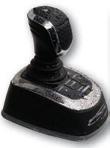



GPS position hold and heading hold is included.
















8 and 99 Kicker Motors in stock. Call

14900 SE STARK ST. • PORTLAND, OR 97233 HOURS: MON-FRI 8AM-6PM • SAT 9AM-3PM MOTORS MUST BE CAPABLE OF ACCEPTING JOYSTICK APPLICATION. CERTAIN LIMITATIONS APPLY. 503-255-8487 • CascadeMarineCenter.com Good Used Boats, Repair Parts, Quality Service, Knowlegeable Staff SALES • SERVICE • ENGINES
now!
Seastar Solutions Optimus EPS steering
YOU THE
Subject to approval by mercury and dealer. Subject to terms. See dealer for details. NO SALES TAX IN OREGON Mercury Marine Outboard Promotion HorespowerConsumer Rebate 9.9 Pro Kicker $100 15 Pro Kicker $150 40 & 40 Jet $200 50 $250 60 & 65 Jet $400 75 & 80 Jet $500 90 $600 115 & 115 ProXS$1,000 150 $1,250 150 ProXS $1,500 350 $2,000 400 $2,250
GETTING
RIGHT PART THE FIRST
From death comes life in the salmon cycle, including back at the garden. “I emptied the bag of salmon heads and carcasses and chopped them into pieces,” Bjorn writes. “My older boy helped scatter the pieces into the dirt of the garden beds … I imagined all the good things that would grow here with a little energy and care.” (BJORN DIHLE)
the animals that had become my family’s food and began the hike home.
WHEN I GOT BACK, I emptied the bag of salmon heads and carcasses and chopped them into pieces. My older boy helped scatter the pieces into the dirt of the garden beds. I nailed tarps and plastic sheeting over afterward, to insulate them for the winter.
The rain was switching to snow as I stepped back to survey the plot. I had much to learn, but I imagined all the good things that would grow here with a little energy and care. My boy called for my attention. He’d found a halved salmon head we’d forgotten and was holding it up to me.

“Is this food?” he asked.
“Yeah, for our garden. We’ll eat a di erent part of the salmon tonight,” I told him.
I lifted a corner of the tarp on one of the beds and we planted the piece of salmon into soil. ASJ


Editor’s note: This piece was originally published in Edible Alaska’s summer 2022 issue and is being republished with the author’s permission. Bjorn Dihle is a lifelong resident of Southeast Alaska. His most recent book is A Shape in the Dark: Living and Dying with Brown Bears. Order it at mountaineers.org/ books/books/a-shape-in-the-dark-livingand-dying-with-brown-bears.

44 ALASKA SPORTING JOURNAL FEBRUARY 2023 | aksportingjournal.com

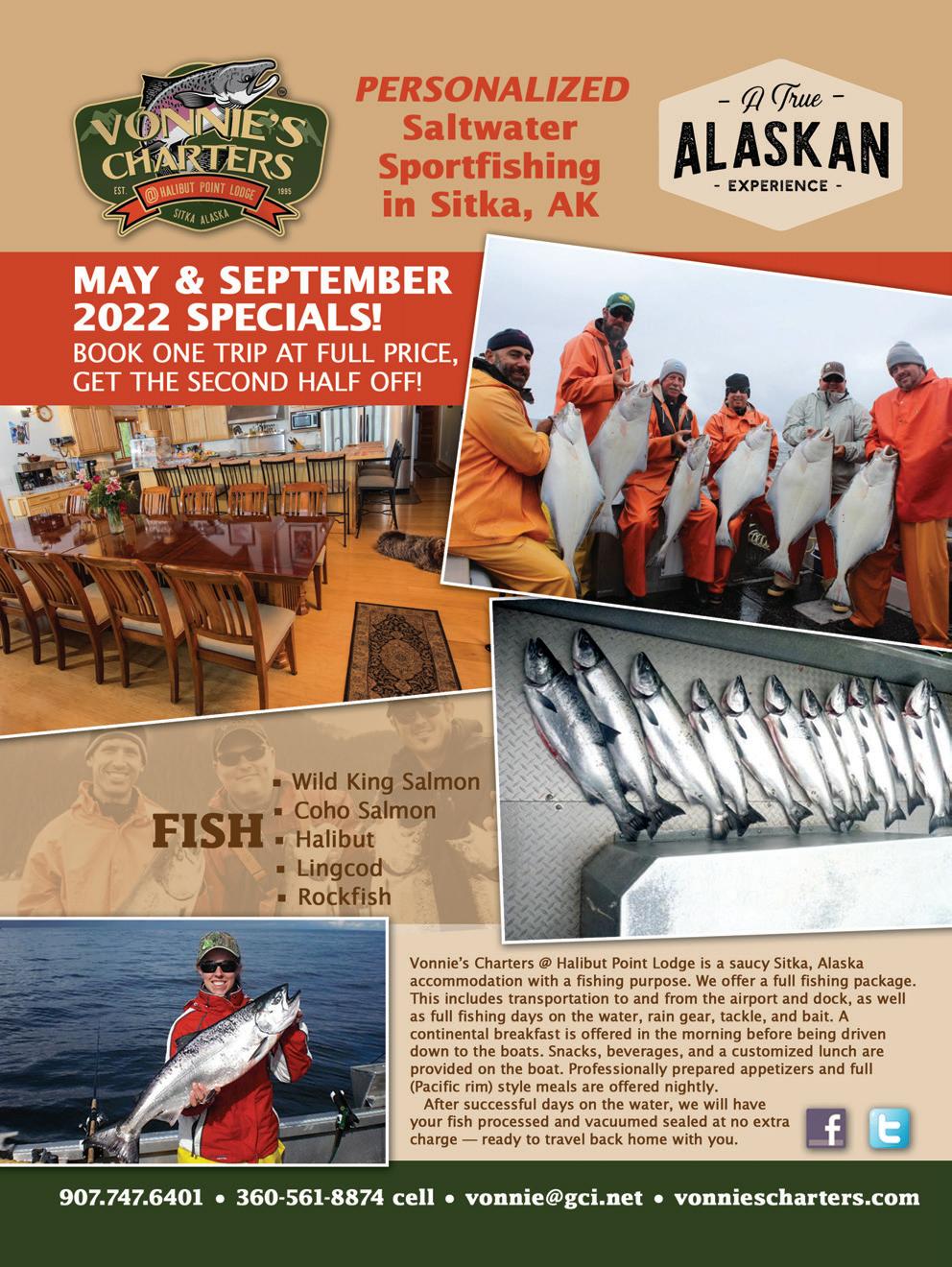
SPIN CLASS IN SESSION
HOW TO BUILD YOUR OWN KILLER COHO SPINNERS

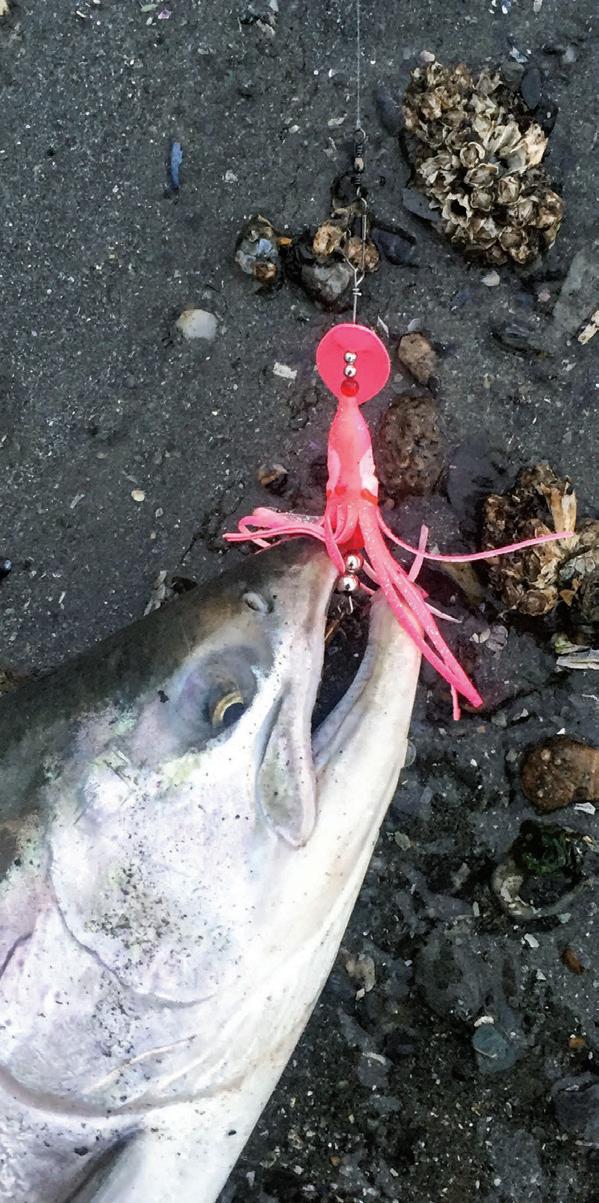 BY BRIAN KELLY
BY BRIAN KELLY
Long, cold winters are the perfect time to build up your coho lure selection for the upcoming season.
Creating your own spinner patterns can give you an edge by giving finicky coho a di erent look after they have seen all the same store-bought patterns during the season. Spinner components – from the blades to the bodies – are available in a wide range of colors, which will allow you to tweak color combos to create that must-have spinner during the peak of the run!
BASIC SPINNER CONSTRUCTION

Start the spinner building process with a 6-inch, .035-inch-diameter, loopedend stainless steel wire shaft. After playing with di erent gage wire over the years, I have found this size to be rugged enough to stand up to the abuse of mean coho without being too rigid, which doesn’t allow as much vibration from the spinner blade.
The looped end is where the build begins by adding a split ring and hook. While hook sizes and style can vary greatly, I tend to stick with a treble in the No. 1 to 1/0 size range for saltwater purposes and a single hook in the same size for flowing freshwater. Always check local regulations for any hooksize restrictions; the use of the split ring will allow for ease of hook style change if necessary.
From here, you can get creative with body styles and beads, but the

aksportingjournal.com | FEBRUARY 2023 ALASKA SPORTING JOURNAL 47
Looking for a DIY challenge that can drive Alaska silver salmon crazy? Try creating your own spinners like author Brian Kelly has. This homemade all-pink squid-skirted spinner was the hot lure on an incoming tide during a Southeast Alaska trip. (BRIAN KELLY)
The components required to create a spinner begin with a 6-inch, .035-inch-diameter, looped-end stainless steel wire shaft. “I have found this size to be rugged enough to stand up to the abuse of mean coho without being too rigid,” author Brian Kelly writes. Other elements include bullet weight, di erent-sized bead spacers, split ring, hook, clevis, blade and plastic squid body. (BRIAN KELLY)
SPINNER CONSTRUCTION: A VISUAL GUIDE
Slide the various lure components down the wire in order (large spacer beads, bullet weight, squid skirt, small spacer beads, clevis with spinner, small spacer bead), and to the wire’s looped end attach the split ring and hook. Note the hook placement – bend even with the end of the squid’s tentacles, not in the middle of the body. (BRIAN KELLY)



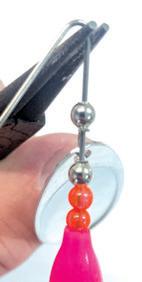


To then form the eye of the spinner, bend the wire around the nose of the plier (lower left), then continue the bend to form the eye (lower middle).
(BRIAN KELLY)
With the spinner complete and ready to fish, remember to check for proper eye alignment, which allows the spinner to swim in a straight line when retrieved. (BRIAN KELLY)
48 ALASKA SPORTING JOURNAL FEBRUARY 2023 | aksportingjournal.com
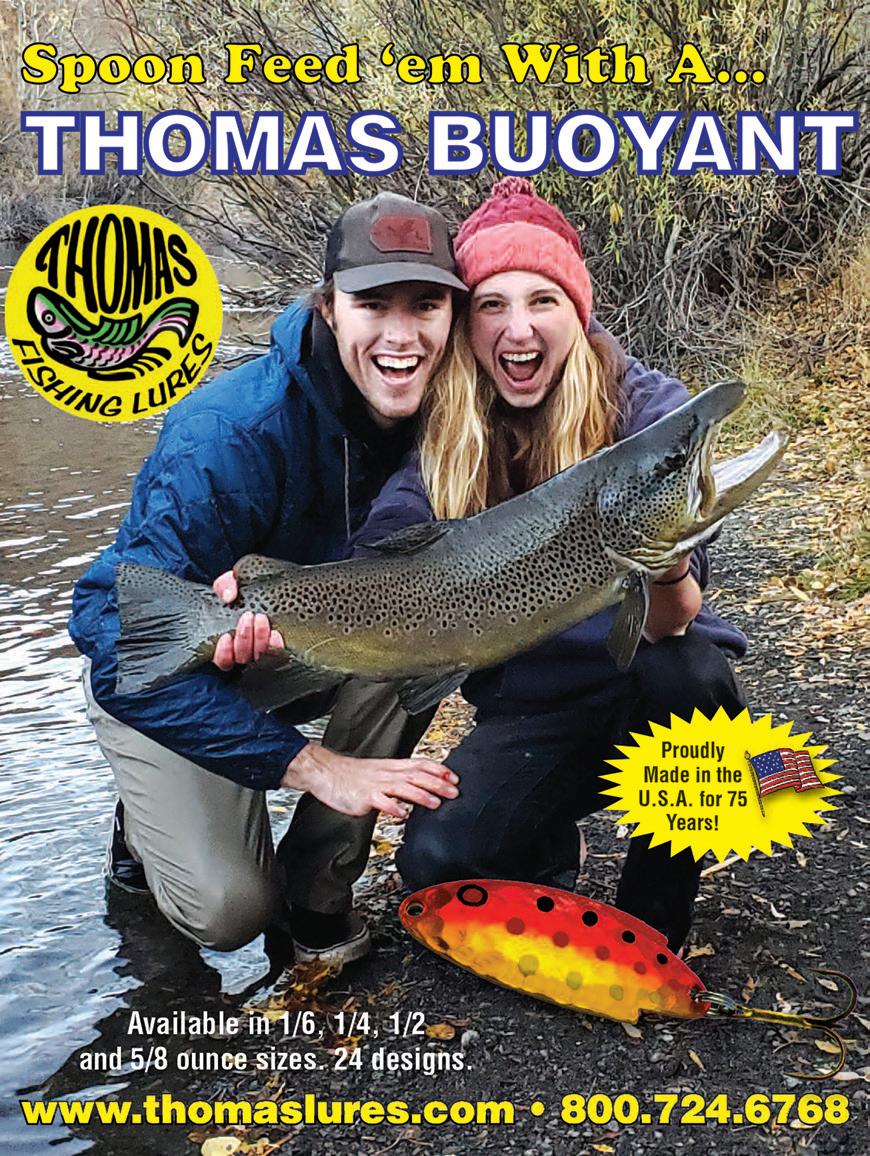
aksportingjournal.com | FEBRUARY 2023 ALASKA SPORTING JOURNAL 49
important part of the spinner equation comes in at the top of the body. No matter what style spinner you are building, put a small plastic bead on the top of the body with a hollow metal bead stacked on top; this combination provides a smooth bearing surface for the clevis to rotate on. Place the spinner blade on the clevis and slide this on the shaft.
The final portion to the build is forming the eye. While there are forming tools available for this step, a pair of small, round nose pliers work just fine for the job. Start by grabbing the wire with the pliers about ⅜ inch above the top of the clevis. Then make the first bend over the top of the plier nose; this will become the top of the spinner eye when complete.
Next, continue to bend the wire around the top of the plier nose until you close the loop. Adjust the plier to hold the loop on the inside of the bend and then wrap the wire around the base of the eye three
The author built a two-tone squid spinner that was the hot lure on a trip to Juneau. “There is a great sense of satisfaction when that first fish eats a lure of your own design,” Kelly says. (BRIAN KELLY)

times and cut the excess wire snug to the eye loop.
The final step is to bend the eye loop if necessary to align the loop with the shaft (see accompanying pictures, page 48). When the eye lines up straight, the spinner will swim true!
THE SQUID SPINNER
There are times when coho just want a bigger-profile lure, especially if they have been keying on herring for their food source. A squid-bodied spinner can be just the ticket in these situations, especially if you are targeting coho in the salt with the feedbag firmly secured.
The build process is pretty much the same as the basic spinner, but be sure to add several plastic beads behind the bullet weight or body to compensate for the added length of the squid skirt. The goal is to have the hook hanging far enough down the skirt to nab any short-
striking fish (see pictures for reference).
Try using a two-tone color scheme with the squid spinner, as this seems to be a consistent pattern for taking coho in the salt. While silver-plated blades are often recommended for most spinner builds, do not overlook painted blades, as these can often turn on a coho in low light conditions.
BRINGING IT ALL TOGETHER
There is a great sense of satisfaction when that first fish eats a lure of your own design. Coho have a reputation for hitting anything that moves, but those who have spent enough time on the water to see the mood swings of Oncorhynchus kisutch know that it pays to have some custom lures and color schemes on hand for those tough bite days.
Spend a little time in the workshop this winter and build a spinner that a coho cannot resist! ASJ
50 ALASKA SPORTING JOURNAL FEBRUARY 2023 | aksportingjournal.com
2.8L




The





Nearly

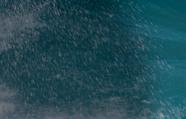

aksportingjournal.com | FEBRUARY 2023 ALASKA SPORTING JOURNAL 51
the water who’s boss with the new F200 In-Line Four. Incredibly light, responsive and fuel efficient, it serves up plenty of muscle to handily propel a variety of boats. On top of that, its 50-amp alternator offers the power to add a range of electronics, and its 26-inch mounting centers and compatibility with either mechanical or digital controls give you the flexibility to easily upgrade your outboard or rigging.
legendary Yamaha reliability and the freedom of forward thinking, with the all-new F200 In-Line Four. THE ALL-NEW F200 IN-LINE FOUR. FORWARD THINKIN REMEMBER to always observe all applicable boating laws Never drink and drive. Dress properly with a USCG-approved personal intended to be an endorsement. © 2013 Yamaha Motor Corporation, U.S.A. All rights reserved. Follow Yamaha on Facebook® and Twitter™ YamahaOutboards.com/F200InLine
Show
Experience
LIGHTWEIGHT.
lightest 200-hp four stroke on the market POWERFUL.
displacement and Variable Camshaft Timing give it the best power-to-weight ratio of any 200-hp four stroke COMPACT.
120 pounds lighter than our four-stroke V6 F200 Show the water who’s boss with the new F200 In-Line Four. Incredibly
it serves up plenty of muscle to handily propel a variety of boats. On top of that, its 50-amp alternator offers the power to add a range of electronics, and its 26-inch mounting centers and compatibility with either mechanical or digital controls give you the flexibility to easily upgrade your outboard or rigging. Experience legendary Yamaha reliability and the freedom of forward thinking, with the all-new F200 In-Line Four. THE ALL-NEW F200 IN-LINE FOUR. FORWARD THINKING. REMEMBER to always observe all applicable boating laws Never drink and drive. Dress properly with a USCG-approved personal intended to be an endorsement. © 2013 Yamaha Motor Corporation, U.S.A. All rights reserved. Follow Yamaha on Facebook® and Twitter™ YamahaOutboards.com/F200InLine WASHINGTON OLYMPIA US Marine Sales & Service 3525 Pacific Ave. SE (360) 455-0788 www.usmarinesales.com
light, responsive and fuel efficient,


52 ALASKA SPORTING JOURNAL FEBRUARY 2023 | aksportingjournal.com
IF YOU BUILD IT…
HOW TO CONSTRUCT A GREAT DUCK BLIND WITHOUT BURNING YOUR WALLET

 BY SCOTT HAUGEN
BY SCOTT HAUGEN
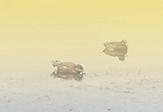
Looking for something to do this winter? If you’re a waterfowl hunter, try building your own blind – on the cheap!
A couple seasons ago I decided to build my own single-panel, low-profile blind. On the first hunt with the blind, I limited out in 15 minutes. The following hunt I had over 700 ducks land in the decoys, but I didn’t shoot for the first five hours because I was seeking a Eurasian wigeon. By season’s end, the
little blind accounted for over 20 limits. The best part? I built the mobile blind for under $30.
A D.I.Y. DUCK BLIND
At a local farm store I paid $23 for a 4-by8-foot cattle panel with 8-inch spaces. Here’s how to create your own blind from this: Using bolt cutters, cut the panel in half down the middle. This will make two blinds, each 4 feet wide. Make the center cuts against a cross section of wire. The
8-inch protruding wires will become the bottom of the blind. These wires can be bent by hand at an angle to stick into the ground you’ll be sitting or laying on. On flat ground, bending the wires at about 45 degrees is ideal; use less of an angle for hunting on elevated, uneven ground. How much you bend the legs and what angle you want the blind can vary from hunt to hunt, but it’s easy to adjust.

When hunting, a 2-foot-long stick can be wedged between the panel and




aksportingjournal.com | FEBRUARY 2023 ALASKA SPORTING JOURNAL 53
FIELD
The author’s homemade panel blind is mobile and low profile. Note the bent top corners, something that’s easy to do by hand and o ers further concealment. (SCOTT HAUGEN)
ADD SOME SMOKED SWEETNESS TO SALMON
BY TIFFANY HAUGEN
Winter in Alaska is the time to keep on top of that freezer supply and make room for this coming season’s fish and game. Be it any of the five salmon species – even steelhead – here’s a recipe worth trying.
Remember, fish marked for “best eating” are also best for smoking. Don’t think a dark, freezer-burned fish is going to be saved by the smoker. Salmon with a high fat content are hard to beat when it comes to smoking fish, so smoking your best cuts should not be overlooked.
For this recipe I used a Little Chief Smoker. It’s still a favorite smoker of mine because it’s simple to use and the temperature stays constant. The Big Chief Smoker is also one we use a lot. When we lived in Alaska, I kept the smoker inside the cardboard box it came in – and also wrapped it in an insulating jacket – to keep the temperature as warm as possible. Just cut a little flap of the box to allow for the
smoker pan and you’re good to go.
When looking to transform a stronger-flavored fish like salmon, think sweet and smoky. Many people who don’t care for a salmon dinner fawn over smoked salmon, while those who think of


salmon as having a “fishy” flavor might change their minds with a fruit-forward recipe. Unique and complex, the subtle smokiness and layered fruit flavors work together to create a very special recipe you’re sure to love.
1 large salmon (or steelhead) fillet

2 tablespoons soy sauce
½ cup grated pear and/or apple
Zest and juice of one orange
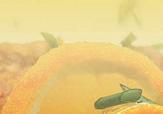

3 tablespoons melted butter


1 tablespoon brown sugar
1 tablespoon rice vinegar


½ inch grated ginger root
½ teaspoon dried coriander
½ teaspoon smoked paprika
½ teaspoon salt
Chive or scallions for garnish
Remove pin bones from fillet. Place soy sauce in a large casserole pan and place salmon or steelhead fillet meat-side down on top of soy sauce. Let sit at room temperature 15 minutes.
In a medium bowl, mix grated apple and/or pear, orange juice and zest, butter, brown sugar, rice vinegar, ginger, coriander, paprika and salt until thoroughly combined.
Preheat Little or Big Chief Smoker 10 to 15 minutes. Add alder chips to the chip pan (any flavored chip works); just be careful not to overpower the ingredients with a strong smoke. Place fillet skin-side down on a smoker rack and smoke 30 to 40 minutes.
Remove fillet from smoker and place on a parchment-lined baking sheet. Top fillet with fruit mixture and bake in a preheated 350-degree oven 15 minutes or until fillet reaches desired doneness or an internal temperature of 135 to 140 degrees. Top with chopped chives or scallions if desired.
Editor’s note: For signed copies of Ti any’s popular book, Cooking Seafood and other bestselling titles, visit ti anyhaugen.com.

54 ALASKA SPORTING JOURNAL FEBRUARY 2023 | aksportingjournal.com
FIELD
Adding the sweetness of fruit such as apples and pears can transform fishy salmon to a more enticing flavor via this Ti any Haugen smoker recipe. (TIFFANY HAUGEN)

FIELD
Cable ties hold grass, or camo mesh, tight to the panel. When on the hunt, simply lay cover on the blind to fill in holes and create a depth of field.

ground for stabilization. Use a finished piece of wood from home, grab one from a tree or get some driftwood. To make a second blind from the remaining panel, cut the cross wire o the bottom to create 8-inch protruding legs.
Get a package of 8-inch, 75-poundrated cable ties to secure camo netting to the blind. A pack of 100 ties can be picked up for under $10. It takes 16 ties to camo the panel.



GET IT ALL COVERED
There are two options to cover the panel. One, wrap the panel in camo mesh and secure it around the edges and middle using the cable ties. I like using burlap
instead of leafy, flimsy material that will get shredded in Alaska’s winds. I picked up a 5-by-10-foot section of camo mesh online for $10. Leave a foot or two of mesh hanging over the sides of the panel to round the edges, which will also hide you and your dog. This is my preferred camo option because it allows the blind to easily be transported and covered with natural vegetation, once afield.

Another camo cover option is to use dry grass or brush, which can be secured directly to the panel. If going this route, be sure to match the blind cover with the habitat you’ll be hunting in.
Once at your hunting location, pull from the natural vegetation and add it to




the blind. Grab handfuls of green grass, brown grass or whatever brush the blind is situated in, and scatter it atop the mesh or existing grass on the blind. If it’s dry and windy, you may need to get some of the cover wet and place that atop the blind so it stays in place.
If choosing to secure grass to the panel, first cable tie a foot or so of camo netting or burlap across the top of the blind. This camo strip will help conceal your face and hand movement when calling, which can be invaluable on sunny days.
LIGHT BUT EFFECTIVE OPTION

Weighing less than 10 pounds, the panel blind is easy to carry. This is a mobile blind designed for moving to and hunting the X. If the wind changes, the sun angle is wrong or birds start working the other end of a pond, slough or field, simply pick up the blind and move. Several times last season I moved two or three times in a morning to get to where ducks were working. I killed a number of geese from this little blind too.
Along with the blind I usually take a dozen floater decoys and a few dozen silhouettes. Going light the whole way around allows for quick and easy moves, plus adjustments can be made on the fly.
The biggest challenge when hunting from this blind is getting a shot. Because you’re usually laying down, it can be hard to sit up, twist, turn and follow ducks. If it’s muddy, a pad will help keep from sliding around in your waders – I sit on my decoy bag – or you can cover the ground in grass or weeds and sit on that. Because movement can be restricted, let the birds work into the decoys in front of you in order to maximize shot opportunities.
CHECK YOUR BLIND
Repair any holes in the blind and add cover as needed as the day and season progresses. I’ll take this small, mobile blind that puts me on the X over roomy, fixed blinds, especially when I can make it on the cheap. ASJ
Editor’s note: For signed copies of Scott Haugen’s bestsellers, visit scotthaugen.com. Follow Scott on Instagram and Facebook.
56 ALASKA SPORTING JOURNAL FEBRUARY 2023 | aksportingjournal.com
(SCOTT HAUGEN)
Wires at the bottom of the blind can be bent by hand and shoved in the ground at a desired angle to optimize concealment. (SCOTT HAUGEN)
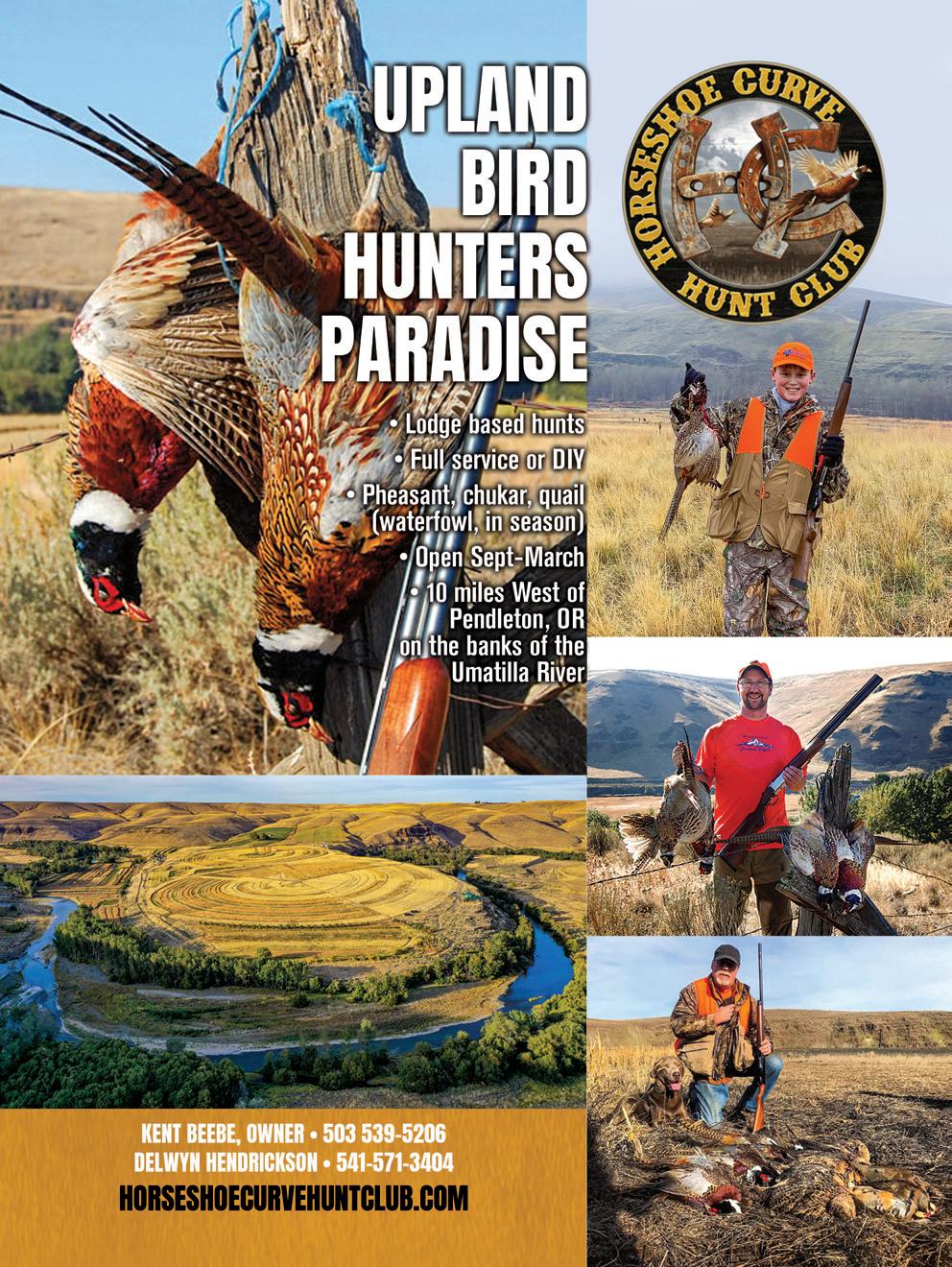
A TURN TO THE SEA
AFTER DEER BECAME SCARCE, SOUTHEAST ALASKA ISLAND WOLVES MOVED TO CONSUMING OTTERS
 BY SEAN NEALON, OREGON STATE UNIVERSITY
BY SEAN NEALON, OREGON STATE UNIVERSITY
CORVALLIS, Ore.–Wolves on a Southeast Alaska island caused a deer population to plummet and switched to primarily eating sea otters in just a few years, a finding scientists at Oregon State University and the Alaska Department of Fish and Game believe is the first case of sea otters becoming the primary food source for a land-based predator.
Using methods such as tracking the wolves with GPS collars and analyzing their scat, the researchers found that in 2015 deer were the primary food of the wolves, representing 75 percent of their diet, while sea otters comprised 25 percent. By 2017, wolves transitioned to primarily consuming sea otters (57 percent of their diet)

58 ALASKA SPORTING JOURNAL FEBRUARY 2023 | aksportingjournal.com
A wolf traveling and foraging in the intertidal zone on Pleasant Island in Southeast Alaska, where sea otters and wolves have become an unlikely prey-predator tandem. “You have top predators feeding on a top predator,” says Taal Levi, an associate professor at OSU. (BJORN DIHLE)
while the frequency of deer declined to 7 percent. That pattern held through 2020, the end of the study period.
“Sea otters are this famous predator in the near-shore ecosystem and wolves are one of the most famous apex predators in terrestrial systems,” said Taal Levi, an associate professor at OSU. “So, it’s pretty surprising that sea otters have become the most important resource feeding wolves. You have top predators feeding on a top predator.”
The findings were published in Proceedings of the National Academy of Science (PNAS).
HISTORICALLY, WOLVES AND SEA otters likely lived in the study area, Pleasant Island, which is located in an island landscape adjacent to Glacier Bay about 40 miles west of Juneau. The island is about 20 square miles, uninhabited and
accessible only by boat or float plane.
During the 1800s and much of the 1900s, populations of sea otters in this region were wiped out from fur trade hunting. Unlike wolves in the continental U.S., Southeast Alaskan wolves were not hunted to local extinction. Only in recent decades, particularly with the reintroduction and legal protection of sea otters, have the populations of both species recovered and once again overlapped, providing new opportunities for predator-prey interactions between the two species.
The researchers studied the wolf pack on Pleasant Island and the adjacent mainland from 2015 to 2021. Gretchen Ro er, a wildlife research biologist with ADFG, and others from the department collected 689 wolf scats, many along the island’s shoreline.
Once the scat is collected, members
of Levi’s lab in Oregon used molecular tools, such as DNA metabarcoding and genotyping of the scat, to identify individual wolves and determine their diets.

Ro er also captured and placed GPS collars on four wolves on the island and nine on the mainland. The researchers were curious whether wolves were traveling between the mainland and island, considering other scientists have found they are capable of swimming up to 8 miles between land masses. Both the GPS collar data and genotypes of the scats confirmed they were not, indicating that the island wolf pack is stable and that the island is not a hunting ground for mainland wolves.
Locations from the GPS-collared wolves also provide evidence that the wolves are killing sea otters when they are in shallow water or are resting on rocks near shore exposed at low tide.
aksportingjournal.com | FEBRUARY 2023 ALASKA SPORTING JOURNAL 59
A wolf drags a sea otter carcass above the tideline at Point Gustavus near Glacier Bay. An Alaska Department of Fish and Game and Oregon State University study found that as deer declined in the area, wolves switched their diet to the marine mammals. (ALASKA DEPARTMENT OF FISH AND GAME)
Ro er and her crew have investigated wolf GPS clusters on Pleasant Island for three, 30-day field seasons since 2021 and found evidence of 28 sea otters killed by wolves.


“The thing that really surprised me is that sea otters became the main prey of wolves on this island,” Ro er said. “Occasionally eating a sea otter that has washed up on the beach because it died, that is not unusual. But the fact that wolves are eating so many of them indicates it has become a widespread behavior pattern throughout this pack and something that they learned how to do very quickly.
“And from the work we are doing investigating kill sites, we are learning that wolves are actively killing the sea otters. So, they aren’t just scavenging sea otters that are dead or dying, they are stalking them and hunting them and killing them and dragging them up onto the land above the high tide line to consume them.”
SHORTLY AFTER WOLVES COLONIZED

Pleasant Island in 2013, the deer population on the island plummeted. With the wolves having consumed most of the deer, their main food source, Levi said he would have expected the wolves to leave the island or die o . Instead, the wolves remained and the pack grew to a density not previously seen with wolf populations, Levi said. The main reason, he believes, is the availability of sea otters as a food source.
The findings outlined in the PNAS paper build on research findings published in 2021 by the same researchers. In that paper they showed – in what they believe is a first – that wolves were eating sea otters. This was documented throughout the Alexander Archipelago, a group of Southeastern Alaskan islands which includes Pleasant Island.
The research has now expanded to study wolves and sea otters in Katmai National Park & Preserve in southwest Alaska, about 700 miles from Pleasant Island. Early research by Ellen Dymit, a doctoral student in Levi’s lab, and Ro er indicates that wolves are also eating
“So, they aren’t just scavenging sea otters that are dead or dying, they are stalking them and hunting them and killing them ... to consume them,” says Ro er. (ALASKA DEPARTMENT OF FISH AND GAME)

sea otters there. In fact, at that location Ro er and Dymit observed three wolves killing a sea otter near the shore.
In addition to Levi and Ro er, coauthors of the PNAS paper are Charlotte Eriksson, a postdoctoral scholar in Levi’s lab, and Jennifer Allen, the environmental genetics lab manager in Levi’s lab. Levi is in OSU’s Department of Fisheries, Wildlife, and Conservation Sciences in the College of Agricultural Sciences. ASJ
Editor’s note: Sean Nealon is the news editor at Oregon State University. For more info on the OSU College of Agricultural Sciences, go to agsci.oregonstate.edu.
Wolves were expected to leave Pleasant Island after eating “most of the deer,” but stayed and what’s more, “the pack grew to a density not previously seen with wolf populations,” likely due to the “availability of sea otters.” (ALASKA DEPARTMENT OF FISH AND GAME)

60 ALASKA SPORTING JOURNAL FEBRUARY 2023 | aksportingjournal.com
Gretchen Ro er, a wildlife research biologist with ADFG, labels a wolf scat sample at the Gustavus Forelands. Scat collection has helped researchers determine wolves’ changing diets. (SEAN NEILSON)
Cumberland’s
Cumberland’s Northwest Trappers Supply is your one-stop trapping supply headquarters, featuring one of the largest inventories in the U.S. We are factory direct distributors on all brands of traps and equipment which allows us to offer competitive prices. Give us a try. Our fast, friendly service will keep you coming back.
Over 50 Years Of Service To The Trap & Fur Industry

CUMBERLAND’S NORTHWEST TRAPPERS SUPPLY







Hide Tan Formula has been used successfully by thousands of hunters and trappers across the U.S. and Canada. No more waiting several months for tanning. Now, you can tan your own hides and furs at home in less than a week, at a fraction of the normal cost. Our Hide Formula tans deer hides either hair-on for a rug or mount, or hair-o for buckskin leather. Tans all fur skins – muskrat, mink, beaver, fox, coyote, raccoon, squirrel, rabbit, etc. It also applies to bear, elk, moose, cowhide, sheep and even snakeskin. Hide Tan Formula is premixed and ready to use and produces a soft, supple Indian-style tan in five to seven days.

One 8-ounce bottle will tan one deer hide in two medium-sized fur skins. Bear, elk, moose and caribou require three to six bottles. Complete instructions are included. You’ll be amazed how easy it is! Tanned hides and furs are great to decorate your home or camp and also to sell for extra income. Tanned hides and furs are in demand by black powder enthusiasts, American Indian traders, fly tyers, country trading posts and many crafters. Our products are proudly produced and bottled in the U.S. for over 20 years.
Available at Cumberland’s Northwest Trappers Supply in Owatonna, Minnesota.
Call (507) 451-7607 or email trapper@nwtrappers.com. nwtrappers.com
aksportingjournal.com | FEBRUARY 2023 ALASKA SPORTING JOURNAL 61
P.O. Box 408, Owatonna, Minnesota 55060 • (507) 451-7607 trapper@nwtrappers.com • www.nwtrappers.com
Northwest Trappers Supply, Inc.
Place
By Phone, Mail Or On Our Website “Trappers Hide Tanning Formula” in the bright orange bottle. Retail & dealer inquiries are welcome. If you get in the area, visit our store!
Request A Catalog Or
An Order




















































































































































 BY CHRIS COCOLES
BY CHRIS COCOLES





































































 BY BRIAN KELLY
BY BRIAN KELLY






















 BY SCOTT HAUGEN
BY SCOTT HAUGEN

























 BY SEAN NEALON, OREGON STATE UNIVERSITY
BY SEAN NEALON, OREGON STATE UNIVERSITY

















